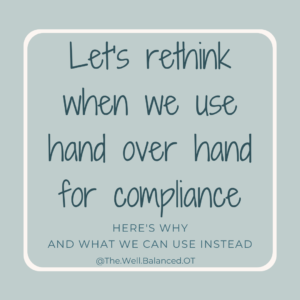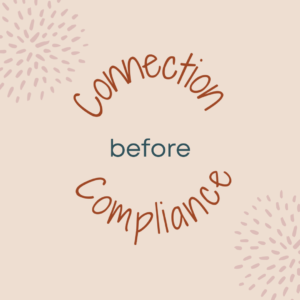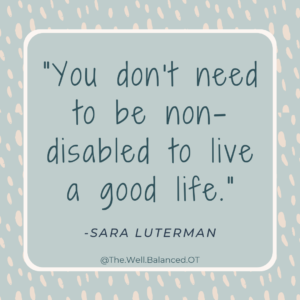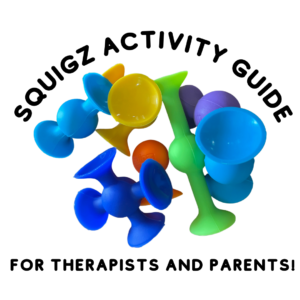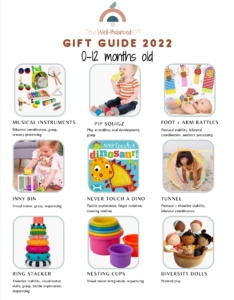You might be thinking, I use hand over hand often! Why should we refrain from using it? Well, in my opinion, especially when using it to get compliance, there are a few reasons.
Hand over hand (HOH) assistance is when an adult places their hand over the childs in order to gain compliance or demonstrate a motor pattern. It might be to place a penny in a bank, hold a pencil to create marks, or use a fork to feed themselves. HOH often is utilized if the child does not initiate the task, is not showing interest, or has difficulty with the movements. When we are using HOH to teach a motor pattern and the child is agreeable, it is totally okay to utilize this strategy and then fade back to less restrictive cues. If we are using it to force a child to engage, we should probably pick a different strategy.
Here’s why we might not want to use HOH to gain compliance:
It does not promote consent.
Children with disabilities are at a higher risk for abuse. We want to teach them that they are in charge of their own bodies and no one has a right to physically touch them without their approval. Yes, we should ask permission prior to touching but we also can show respect by listening to their body language and various forms of communication, especially if they are non-speaking. Looking away from the paper on their desk or not picking up their writing utensil is non-verbal communication.
It is extremely restrictive and invasive.
Physical assistance is the most restrictive and invasive form of assistance we can give. In therapy, we always strive for the least restrictive environment. We try to phase out assist cues to increase independence fairly quickly. For example, if I have a child that is working on bilateral coordination, I am not going to place my hands over theirs to play. I might try to hand them something to encourage them to reach forward or tap the thing I want them to pick up. If that doesn’t work, I might take one finger and initially nudge their arm forward at the elbow.
It does not focus on building intrinsic motivation.
When a child is intrinsically motivated, they are more interested in participating that we don’t need to use any physical assistance to get them to complete the task. It’s also been found that intrinsic motivation is better for long-term learning. Focusing on child-led activities and incorporating their interests into your planning will help build this motivation!
It teaches dependency, not independence.
Many of our children are routine-based. So when we place our hand over theirs, instead of learning how to do the task on their own, they learn that they can only complete the task when your hand is helping. You’ll find these kids often giving you their hand because they are so used to HOH being the norm.
It often is provided without the child providing any visual attention to the task at hand.
I can’t tell you how many times I’ve seen a teacher sit with a child to engage in a HOH task and the child is looking everywhere except at their paper. Yes, he might be tracing his name with Max Assist but if he’s not controlling the pencil and not visually attending to what’s in front of him will this generalize to greater independence?
Physical prompts can put the child in fight, flight, or freeze which is not the optimal time for learning.
When we are scared or overstimulated, our sympathetic nervous system takes over and puts us in fight, flight, or freeze. When we are in this phase, our brain is not capable of retaining information and learning new things because its only focus is to protect. This is the worst time to try to teach another person. It’s the same reason we wait until after the meltdown to discuss what happened.
What can we use instead of hand over hand?
Model what you want. Working on stringing beads? Have two sets so you can show them how to sequence the activity. If they don’t watch what you are doing, use big facial expressions and sounds. I like to make the bead go “WEEEEEE” down the string (as if it were going down a slide).
Increase intrinsic motivation. What do they like? Obsessed with trains? Put a train sticker on the pencil. Love paw patrol? Use a Ryder and Everest as two endpoints when drawing a line.
Focus on the underlying skill. Ask why is this hard? Why aren’t they drawing lines? Can they even stabilize a pencil yet? Are they scribbling? Are they weak throughout their core and don’t have enough postural control to stabilize the shoulder girdle yet? There are so many reasons why a child might not comply to a request. Let’s look a little deeper.
Pay attention to body cues: These cues will help you understand what state of regulation the child is in. Don’t know how to read cues? Check out this blog post
Visual, verbal, and gestural cues. Each of these cues are much less restrictive. FYI, in order from most to least restrictive: Physical, model, visual, gestural, verbal.

